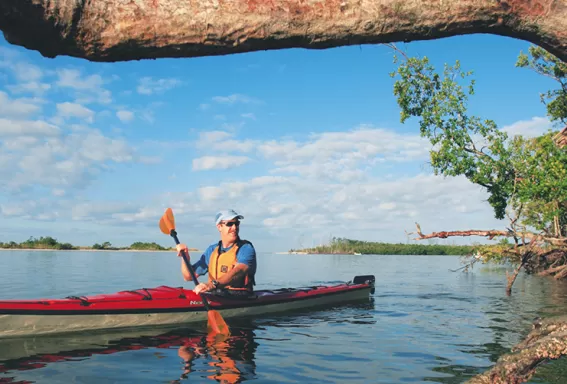Great Calusa Blueway
Wildlife Around Every Turn
As you paddle the Great Calusa Blueway, you’ll come across all sorts of wildlife, from 1,200-pound manatees to elegant roseate spoonbills. Each has a favorite ecosystem or part of the area they call home.
Manatees
The Florida manatee is an endangered species. Habitat encroachment, boat collisions and red tide have claimed many of these gentle giants. These slow-moving creatures live in and around Estero Bay's waters primarily during the summer months. During these warm-water periods, they spend their days feeding and resting.
Manatees reach an average size of about 10 feet and 1,200 pounds. Their distant relationship to elephants can be seen in their grayish-brown skin and the toenails visible on the edges of their flippers. Like all mammals, manatees have lungs and must surface to breathe, something they do every five minutes or so when active. While resting, manatees can hold their breath for up to 20 minutes.
Although they are solitary creatures by nature, it's possible to see groups of manatees swimming or feeding together. These groups are typically small, numbering four or five. Larger groups of a dozen or more are sometimes spotted.
During the winter, most of the bay's manatees migrate to warmer waters, making their way to Manatee Park, located near the warm waters of the Fort Myers Power Plant. Some of the larger males have enough natural insulation to withstand the colder winter temperatures, however, and remain in Estero Bay year-round.
Dolphins (Information Kindly Provided by Project Pod)
The Fort Myers area is home to the Atlantic bottlenose dolphin, a type of small, toothed whale that inhabits warm, salt and brackish waters. Dolphins belong to the order Cetacea, a grouping that includes the large baleen whales as well as their smaller cousins, the porpoises. The dolphins in the bay are coastal bottlenose dolphins. They ply the waters of the bay itself and the near-shore coastal waters. Farther out in the Gulf, you might encounter the larger bottlenose dolphins that represent a distinct population seldom if ever seen near the coastline.
These coastal dolphins are an average of nine feet long and weigh in at approximately 500 pounds. They have distinct home ranges: areas of water in which they spend most of their time. Consequently, the individuals you see in the bay live here year-round.
Explore the various ecosystems and take note of the different species that gather in each one.
Mangroves
Animals found in the mangroves include (mammals) rabbits, raccoons and bobcats; (birds) frigate birds, roseate spoonbills, pelicans, cormorants, egrets and herons; (fish) tarpon, snook, snapper, killifish, mosquitofish and mullet; (invertebrates) mangrove tree crabs, fiddler crab, blue crab, oysters, shrimp, snails and mosquitos.
Rookery Islands
Birds that nest and raise their young on area rookery islands include great blue heron, tri-color heron, little blue heron, brown pelican, white ibis, reddish egret, roseate spoonbill, great white heron, great egret, snowy egret, magnificent frigate bird, anhinga, green heron, cattle egret and cormorant.
Tidal Flats
Birds found in and around tidal flats include brown and white pelicans, herons, ibis, plovers, sandpipers, sowitchers, gulls, terns, skimmers, American oystercatchers and falcons.
Oyster Bars
Animals found in the oyster bars include barnacles, shrimp, crabs, worms and mussels. Birds and predatory fish such as redfish and snook inhabit these areas at high tide.
Hardwood Hammocks
Animals found on coastal hardwood hammocks include oppossums, raccoons, gopher tortoises, eastern indigo shakes, garter snakes, blacksnakes and mangrove fox squirrels.

